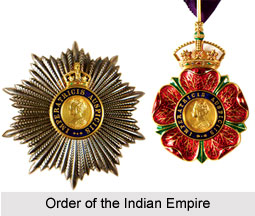 Order of the Indian Empire, also known as The Most Eminent Order of the Indian Empire is an order of chivalry established by Queen Victoria in the year 1878. The Order of the Indian Empire includes members of 3 classes, namely Knight Grand Commander (GCIE), Knight Commander (KCIE) and Companion (CIE). Since the Partition of India in the year 1947 no appointments have been made after that. The Maharaja of Dhrangadhra was the last surviving knight who died in 2010and the order became inactive and dormant after that. The motto of the Order of the Indian Empire is "Imperatricis auspiciis" meaning under the auspices of the Empress, which refers to the first Empress of India Queen Victoria. This particular order is the junior order of chivalry which is related with the Empire of India; where as the senior order is The Most Exalted Order of the Star of India. The Imperial Order of the Crown of India was for women only. Members of all classes of the Order were assigned positions in the order of precedence.
Order of the Indian Empire, also known as The Most Eminent Order of the Indian Empire is an order of chivalry established by Queen Victoria in the year 1878. The Order of the Indian Empire includes members of 3 classes, namely Knight Grand Commander (GCIE), Knight Commander (KCIE) and Companion (CIE). Since the Partition of India in the year 1947 no appointments have been made after that. The Maharaja of Dhrangadhra was the last surviving knight who died in 2010and the order became inactive and dormant after that. The motto of the Order of the Indian Empire is "Imperatricis auspiciis" meaning under the auspices of the Empress, which refers to the first Empress of India Queen Victoria. This particular order is the junior order of chivalry which is related with the Empire of India; where as the senior order is The Most Exalted Order of the Star of India. The Imperial Order of the Crown of India was for women only. Members of all classes of the Order were assigned positions in the order of precedence.
History of Order of the Indian Empire
Several years after the Indian rebellion and the union of the power of the British Empire as the governing authority in India, it was decided by the British Imperial administration that a new order of knighthood would be created in order to honour Indian Princes, small kings and local chiefs. Apart from this, it was also decided that some of the British officers and administrators who served in India would also be honoured. Thus the Most Eminent Order of the Indian Empire was founded by the British in the year 1878 in order to reward native and British officials who served in the country. This particular Order initially contained only the Companion class, but later extended to consist of 2 classes by the year 1887. As per the intention of the British authorities, the Order of the Indian Empire was a less exclusive version of the Order of the Star of India, which was founded by the Queen in 1861. Accordingly, a number of appointments were made to the Order of the Indian Empire than to The Most Exalted Order of the Star of India.
The Order of the Indian Empire officially came to be known as The Most Eminent Order of the Indian Empire on 15 February 1887. It was divided into two classes Knights Commander and Companions.
First Knights Commander of Order of the Indian Empire
The first Knights Commander of The Most Eminent Order of the Indian Empire are-
* Bhagvat Singh of Gondal
* General Sir Frederick Sleigh Roberts
* Sir Alfred Comyns Lyall
* Edward Drummond
* Rana Shankar Baksh Singh
* Robert Anstruther Dalyell
* Maxwell Melvill
* Sir Monier Williams
* Ranjit Singh, Raja of Ratlam
* Pusapati Ananda Gajapati Raju, Maharaja of Vizianagram
* Dietrich Brandis
* Alexander Cunningham
* Nawab Munir ud-Daula Salar Jang, the Prime Minister of Hyderabad
* Honourable Nawab Sir Imam Buksh Khan Mazari
* Donald Campbell Macnabb
* George Christopher Molesworth Birdwood
* Sayyid Hassan Ali Khan Bahadur, Nawab of Murshidabad
* Lachmessur Singh, Maharaja of Darbhanga
* Albert James Leppoc Cappel
* Surgeon-General Benjamin Simpson
* Alfred Woodley Croft
* Bapu Sahib Avar
* Donald Mackenzie Wallace
* Bradford Leslie
On 5th January 1888, a further proclamation regarding the Order of the Indian Empire was made and was extended to 3 classes, Knight Grand Commander, Knight Commander and Companion.
Seven Knights Grand Commander were appointed, they are mentioned below-
* HRH The Prince of Wales
* HRH The Duke of Connaught and Strathearn
* HRH The Duke of Edinburgh
* HRH The Duke of Cambridge
* The Lord Connemara, Governor of Madras
* The Lord Reay, Governor of Bombay
* General Sir Frederick Sleigh Roberts
Appointments to The Most Eminent Order of the Indian Empire ceased after 14 August 1947. The Order was never been formally abolished and Queen Elizabeth II remains as the Sovereign of the Order even to the present day. At present there are no surviving members of the Order of the Indian Empire.
HH Maharaja Sri Sir Chithira Thirunal Balarama Varma, Maharaja of Travancore, was the last surviving Knight Grand Commander (GCIE) who died in Trivandrum on 19th July 1991. The Maharaja of Dhrangadhra Halvad, HH Maharaja Sri Sir the Maharaja of Dhrangadhra was the last surviving Knight Commander (KCIE), who died on died on 1st August 2010 at Dhrangadhra.






































